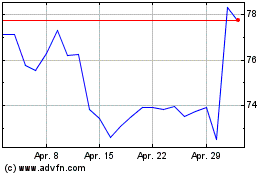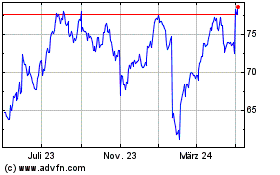By David Benoit And Jacob Bunge
Shortly after Edward Breen stepped in to run DuPont Co. in
October, Andrew Liveris, longtime head of Dow Chemical Co., called
with a proposal.
Mr. Liveris saw an opportunity to strike the merger he had long
wanted, marrying the two giants of American industry with a
combined market capitalization of more than $130 billion, and he
was eager to talk to the noted deal maker now leading his
rival.
Mr. Breen asked for some time. He later joked with bankers that
he hadn't even had a chance to find the bathrooms at DuPont when
Mr. Liveris came calling, according to people familiar with the
matter.
Nine weeks later, Dow and DuPont are on the verge of
consummating a deal. The two are in advanced talks on a merger that
would reshape the chemical and agricultural industries by creating
a new massive company, which would quickly be spun into three
entities, The Wall Street Journal reported Tuesday. A deal could be
announced as soon as this week.
It comes at a time of sinking commodity prices and a
strengthening U.S. dollar, which have hurt revenues across the
companies' business lines. Both companies have shed some of their
hallmark businesses that generated lower profits and left them
exposed to price swings, while focusing on proprietary products in
faster-growing sectors such as food, electronics and packaging.
Dow and DuPont also have cut costs and streamlined operations,
but both drew critiques from activist investors-- Nelson Peltz's
Trian Fund Management LP at DuPont and Daniel Loeb's Third Point
LLC at Dow--who said executives moved too slowly and that the
companies were still too big and losing ground to nimbler
competitors.
By combining and then breaking up, DuPont and Dow see a way to
speed the process in one fell swoop, while creating an agricultural
giant and a materials maker that could each be worth more than the
current stand-alone companies, according to the people familiar
with the talks.
Agriculture would account for 23% of Dow and DuPont's combined
revenue; performance materials and chemicals 48%; and other
divisions, like nutrition and consumer products, would make up 29%.
The companies in 2014 generated $93.2 billion in combined
sales.
Shareholders cheered the idea on Wednesday, sending both
companies' stocks up 12%, adding a combined $14 billion in market
value. Dow gained $6.07 to $56.97, while DuPont gained $7.89 to
$74.49--the largest dollar gains for each since at least 1972.
Mr. Liveris has been pushing for a deal for much of his 11-year
tenure at Dow, the world's second-biggest chemical manufacturer. He
has bet the Midland, Mich., company's future on material-sciences
products used in industrial, automotive and construction sectors
that come with high prices that are less tied to underlying
commodities.
To do that, he needs to reduce Dow's exposure to agriculture
sciences that make seeds and various other chemicals based on
petroleum products.
DuPont, in Wilmington, Del., was facing similar pressures and
looking to also boost margins and reduce the cyclical nature of its
business. It started growing its agricultural businesses, sold its
paints business and spun off a performance-chemicals business.
Mr. Liveris had tried to strike a deal before, attempting to buy
DuPont in 2006, people familiar with the matter said. When that
went nowhere, Mr. Liveris acquired specialty chemicals producer
Rohm & Haas Chemicals LLC in 2009, a $16 billion deal struck
just as the market for financing collapsed.
The deal nearly fell apart, and the debt burden forced Mr.
Liveris to break a pledge to never cut Dow's dividend and to take a
$3 billion rescue financing package from Warren Buffett.
Mr. Liveris tried repeatedly to get DuPont to come to the table,
the people said. He engaged in talks with Ellen Kullman, who took
over DuPont in 2009, they said, but the talks never amounted to a
deal.
Ms. Kullman's tenure ended abruptly this October. She had
survived a proxy fight with Trian, which had argued for a breakup
of agriculture and industrial products. Ms. Kullman won a close
shareholder vote in May partly by promising DuPont would hit
earnings targets.
But when DuPont's earnings failed to turn around and shares fell
for months after DuPont's annual meeting, Ms. Kullman announced she
would retire. Mr. Breen, a noted turnaround artist who broke up
Tyco International PLC and created large shareholder returns there,
was named DuPont's interim chief executive.
The change set off a round of talks among those in the
agricultural industry. Already St. Louis-based Monsanto Co. had
sought to acquire Syngenta AG for $46 billion--an idea the Swiss
company rejected. Messrs. Breen and Liveris both publicly declared
they would entertain deals.
After Mr. Breen found his bearings at DuPont, the two executives
began talking about their entire companies, not just the
agriculture units. Mr. Liveris presented the idea he thought would
bring the most value: A merger of equals followed quickly by a
breakup into an agricultural company and a materials company, the
people said.
Mr. Breen quickly saw the financial possibilities but suggested
a further split, with a third business for various specialty
chemical products like nutrition that didn't fit with the other
two, the people said.
The combined entity would allow them to rapidly cut some $3
billion in costs, and then spin out three specialized companies
that have differing research-and-development needs and can attract
different investors, the people said.
Breakups for those reasons have been in vogue in the U.S., as
activists pressure companies to sharpen their focus. The trend has
collided with a record year for mergers and acquisitions, with
Pfizer Inc. and Allergan PLC announcing a similar megamerger
followed by a plan to separate some assets.
Dow and DuPont believed the planned splits would alleviate
concerns about antitrust regulators blocking a deal, the people
said. Though the deal would create a company with high market share
in several businesses, the stand-alone entities would continue to
face stiff competition, the people said.
DuPont removed the interim tag from Mr. Breen's title on Nov. 9,
naming him officially chairman and chief executive.
Trian blessed the move, it had told the board before the
announcement, people familiar with the matter said. But it still
expected to see improved results and laid out a plan for him to get
there, the people said. Trian has supported the deal talks and
encouraged the DuPont board to reach an agreement, people familiar
with the matter said.
At the same time, Mr. Liveris and Dow were gearing up for their
own activist investor to re-emerge.
In January 2014, Mr. Loeb's Third Point had taken what was then
a $1.3 billion stake in the company and began calling for a split
of its petrochemical products, about two-thirds of Dow's revenue,
from specialty products, which includes agriculture, food,
pharmaceuticals and electronics. Mr. Loeb neared a proxy fight,
launching a website and a political-ad style video lambasting Mr.
Liveris for mismanagement. The sides settled quickly, with both
appointing two directors to the Dow board, and an agreement that
kept Mr. Loeb from speaking on Dow publicly for a year.
The activist's view on Mr. Liveris hasn't changed, and Mr. Loeb
was expected to call for a management change, people familiar with
the matter said. This weekend, that standstill expires.
(END) Dow Jones Newswires
December 09, 2015 20:15 ET (01:15 GMT)
Copyright (c) 2015 Dow Jones & Company, Inc.
DuPont de Nemours (NYSE:DD)
Historical Stock Chart
Von Jun 2024 bis Jul 2024

DuPont de Nemours (NYSE:DD)
Historical Stock Chart
Von Jul 2023 bis Jul 2024
